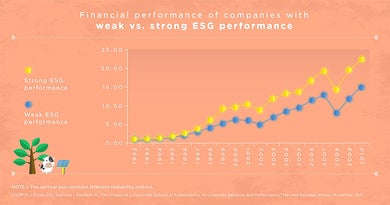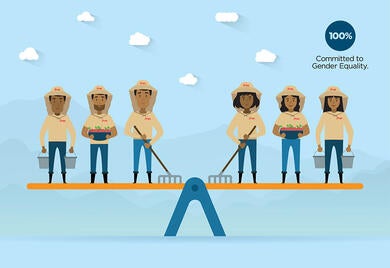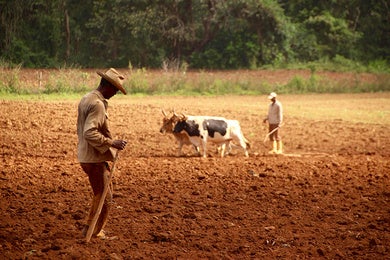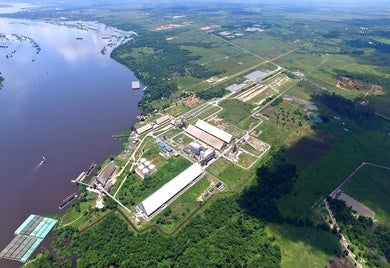
What Imminent Opportunities and Challenges Does Our Region’s Agro-industry Present?
With the evolution of agro-industry, competing pressures, opportunities, and new challenges arise leading to a reformulation of the sector’s bases and forms.

A Lifesaver for Agribusiness: the Financial Resiliency Clause
Exposed to phenomena such as El Niño, agribusinesses in Latin America and the Caribbean require protection by the financial system. One tool for this is the financial resiliency clause, developed to address the reality of climate change and the challenge posed by different natural disasters.

Sustainability boosts agribusinesses
The gap between companies that do only what is essential in managing sustainability versus those who are already capturing its benefits could soon become an irreversible gap that buries some but catapults others.

How can gender equality boost agribusiness?
The impact of female participation in agribusiness is one of the highest in the global economy. Women laborers produce between 60% and 80% of food in developing countries, and around the world there are about 1.6 billion women laborers, according to the United Nations Food and Agriculture Organization (FAO). Gender equality in this sector is key, so much so that family-sized farm yields could increase by up to 30% if women had the same access as men to land and resources. In terms of retention and quality of employment, female representation is important and that’s why agribusiness companies are working to provide the same opportunities for men and women. One of them is DanPer in Peru, which employs more than 6,500 people and has about 7,000 hectares cultivated throughout the country. [clickToTweet tweet="Women laborers produce between 60% and 80% of food in developing countries #equidadtotal" quote="Women laborers produce between 60% and 80% of food in developing countries" theme="style1"] DanPer has been working on gender equality since its inception and, motivated by its desire to improve in this area, recently completed the EDGE certification process. This certification measures standards of equality and also supports companies to develop a work plan to establish improvements in the future. Today, they are the first agribusiness company in Peru that has this certification. Intrigued by the effects of gender equality on agribusiness, I asked Roger Carruitero, Central Manager of Human Capital Management at DanPer, about this experience: In recent years, what changes have you seen in the treatment of women employees at the company, thanks to the implementation of gender equality practices? For DanPer, sustainability is one of the main pillars for the advancement of our people, and we want to ensure that we provide the same opportunities to women and men. For this reason, when we saw the opportunity of measuring our gender equality and learning about other experiences, we seized it immediately. That is why we applied to the EDGE certification, with the support of the IDB Group. EDGE has allowed us to strengthen our processes of managing people with an inclusive approach. By developing work plans and timetables with specific actions, we ensure the adoption of gender equality as a standard practice in our organization. So today we make use of inclusive language and adopt communication policies. In addition, this component is present in our selection, training, hiring and promotion of personnel. Finally, we encourage the participation of women and men in gender equality dialogues to monitor and measure our progress. How have advancements made in gender equity helped the business? EDGE certification has allowed us to strengthen the diversity of the company and reach a more competitive professional market, attracting quality human talent. Practices such as the expansion of the free services offered by our health service in processing plants and agricultural funds allow us to achieve greater welfare for our workers. Today, this center includes exclusive services for women such as gynecological checkups (including cancer screenings), obstetrics and pregnancy services that help us reduce absenteeism, desertions, and turnover levels. Thus we achieve greater well-being in our workers, who in many cases would have to go to hospitals where they would take longer to be treated. The greater return on personnel, less absenteeism and a decrease in turnover allows us to be more productive, because we have personnel with greater experience and skillsets. This allows our collaborators to have higher incomes that are invested mainly in a better education for their children, many of whom manage to complete technical and university studies. This higher productivity, in turn, generates savings in recruitment, selection, transportation and clothing expenses that solve a significant part of the health budget. What else would you like to see to increase the opportunities for gender equality in DanPer? Today, our challenge is to ensure that every day more women have access to positions of power at the mid- to upper levels. For this we must undertake a number of actions, including ensuring that higher education institutions provide the agribusiness industry with a greater supply of graduates in careers whose approach is erroneously directed toward men. This will allow us to have more women applying for mid-level and executive positions in the areas of agricultural production. In the same way we hope to apply it to positions that require technical training, such as mechanics, truck drivers and hopefully tractor drivers. Regardless, we must continue conducting training and awareness programs on gender equality and non-discrimination in all our headquarters. There is much to do and we are on the right track! At DanPer, the benefits of gender equality are obvious. Today, as leaders in the field, they participate in events throughout Peru and abroad, where they share their model and seek to raise awareness of the importance of being systematic in adopting measures that reduce and eliminate gender gaps. "Equality for women is progress for all," as Ban Ki-moon said, especially in an industry where equality could reduce world hunger by as much as 150 million. Subscribe to receive more content like this! [mc4wp_form]

Why is social inclusion good for agribusiness?
By 2050, a 60% increase of food production will be required, with only a 12% increase in arable land. Considering the social and demographic implications for agricultural producers, finding solutions to include them in production chains is a must. Latin America and the Caribbean region is the largest net exporter of food worldwide. Furthermore, the region has a third of the global fresh water resources, more than a fourth of high-to-medium potential production lands, and around 40% of biodiversity. However, the region has 14 million small-scale family farming, in vulnerable situation, who occupy 80% of the farms, produce 35% of lands, and provide between 40% and 50% of food, according to the study “The Next Global Breadbasket: How Latin America can Feed the World”. Gaps among agricultural producers Whether to raise cattle in Paraguay, grow coffee in Colombia or soy in Brazil, all kinds of agricultural producers are involved in the process, from large businesses to small producers and smallholders, including cooperatives. Although there are also intermediary actors, like in Argentina or Uruguay where larger scales are achieved by leasing lands. This is an already proven business model where the producers are not necessarily land owners. However, among these different types of producers there are gaps that are increasingly evident in terms of scale, access to financing and markets, and technology application. This issue is even more evident among small producers: only 5% has access to formal borrowing, and the continuous fragmentation of land ownership due to the inheritance factor (many times resulting in flawed titles) works against them when trying to achieve minimum scales. The key factor of this gap arises from the climate change effects (which is more evident in Central America due to the narrow distance between both oceans) that, together with scarce and expensive financing, price volatility, increasingly sophisticated technological advances, and climate insurance limitations, impact family farms income. As result, younger generations choose to migrate to large urban centers instead of continuing working in family farms, and thus an important social structure of rural communities keeps on deteriorating. In Mexico alone, the number of people living in rural areas decreased from 57% in 1950 to 29% in 1990, and 22% in 2010, according to the Instituto Nacional de Estadística y Geografía de México (Inegui). David and Goliath’s tale Meanwhile, the consolidation of producers could help the so-called “new generation of cooperatives” and other association forms to achieve larger production volumes to leverage their negotiation power. Along these lines, geopolitics and the global struggle to supply commodities continue being strategic for certain countries, and could become an opportunity for producers. The entry of the Chinese company, COFCO, after acquiring Nidera and Noble Agri, or the purchase of Agro Amazonia in Brazil by the Japanese Sumitomo Corp., are proof of this situation. While on the other side of the chain, if the regulating entities approve the mergers of Bayer-Monsanto, Dow-Dupont, and Syngenta-Chemchina, these companies would control 60% of the seed/biotechnology business, and 70% of the agrochemical industry. How to promote inclusion in production chains So, what can be done to promote inclusion in production chains? While some companies focus their acquisition strategies to purchase commodities from large-scale producers, other companies seek to develop their smaller clients, not only driven by a more social approach, but also because according to FAO, they have a productivity growth potential of 30% to 50% in sugar cane, dairy, and cattle production. To close the productivity gap, a likely and sustainable solution for small producers is long-term financing, provided by investment banking —through trust funds or similar vehicles—, in association with anchor businesses assuming part of the risk and supporting them with technical assistance programs. An example of this trend is the structured financing implemented by IDB Invest (formerly known as Inter-American Investment Corporation) and the International Finance Corporation (IFC), together with ECOM —a global coffee business— and Starbucks for coffee producers that have been affected by rust disease in Nicaragua. This article was originally published at the Huffington Post. Subscribe to receive more content like this! [mc4wp_form]

Soy: Paraguay’s “Green Gold”
This is the story of a small seed from Asia that has transformed the economy of a country in the heart of South America. Soy, a legume brought to Paraguay in the 50’s by immigrants from Japan, is today the country's main export product.